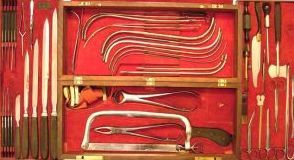Authentic Period Civil War Medical Items  Civil War Surgical Sets Medical Text Books and Surgical Manuals Articles on Civil War Medicine See our Articles On Civil War Medicine |
Reading Civil War medical documentation can sometimes be frustrating because of the terms used in the material. Below are some common medical terms used during the Civil War, and will assist in helping the reader in understanding exactly what is happening with the patient.
* ague: Fever, or other recurrent symptom resulting from malaria also known as a chill. It was a common synonym for intermittent fever.
* amputation: Removal of an appendage of the body, usually a limb. circular: Using a single flap and by making a circular cut at a 90 degree angle to the long axis of the appendage.
primary: surgery done following the period of shock and before inflammation sets in. Most amputations were done within the first 24 hours.
secondary: usually performed to improve an earlier amputation.
* anodynes: medicine that relieves pain
* apoplexy: stroke; sudden impairment due to a cranial hemorrhage. It could also refer to extravasation of blood in any organ.
* asthenia: weakness
* bilious attack: certain diseases such as malaria or typhoid was sometimes designated as bilious fever. Applied to group of symptoms consisting of headache, abdominal pain, and constipation. Commonly name given to migraines or acute dyspepsia.
* blue mass: also known as blue pill. It was a mercury mass used for many conditions.
* Bright’s disease: general term for kidney diseases.
* Camp, state: made up of various symptoms such as fever or diarrhea which happened when troops were crowded together.
* catarrhus: inflammation of the mucus membranes.
* cholera: acute infectious disease characterized by severe diarrhea with extreme fluid losses, the resulting dehydration and electrolyte loss often leading to death. Different types included Asiatic and morbus.
* colica: acute abdominal pain
* consumption: wasting away of the body. Generally applied to tuberculosis.
* debility: lack or loss of strength. Debility is generally considered to be lasting.
* dementia: insanity. Organic loss of intellectual function.
* dengue: also known as 'break bone fever'. An infectious disease which is characterized by severe pains in the eyes, head, and extremities and accompanied by catarrhal symptoms. Transmitted by the bite of a mosquito.
* dysentery: inflammation of the intestines. The cause could be a chemical irritant, bacteria, or parasites.
* dyspepsia: term used to describe epigastric discomfort after meals. It refers to a state in the stomach in which functions are disturbed.
* dyspena: difficulty in breathing.
* erysipelas: a very contagious skin disease due to areas being infected with a strep germ. It is characterized by redness and swelling of the affected areas. It generally lasted between 10 and 14 days. Most infections of wounds were more likely not this disease and actually cellulitis.
* excision: removal by cutting. Done usually instead of performing an amputation.
* fevers: elevation of body temperature above normal.
Camp: included typhoid and many other diseases; a catch-all phrase.
intermittent: recurring fevers; usually malaria was the cause.
remittent: usually used to refer to malaria
typhoid: a disease characterized by chills, fever, abdominal distention, and an enlarged spleen.
yellow: acute infectious disease transmitted by mosquitoes in which the symptoms are jaundice, fever, and protein. Has two stages in which delirium and coma could be the results of the second one.
* grippe: also known as influenza. Acute viral infection of the respiratory tract.
* malaria: disease caused by a protozoa. It is parasitic of red blood cells and is transmitted by mosquitoes. Symptoms included chills, fever, and sweating. Often chronic and recurring.
* morbi: diseased or unhealthy.
* mortification: death.
* osteomytelitis: inflammation of bone. A common surgical fever.
* peritonitis: often the cause of death in abdominal wounds. Inflammation of the internal membrane lining the abdomen and pelvic walls.
* pneumonia: inflammation of the lungs. Different types included hypostatic, senile, and typhoid.
* prostration: extreme exhaustion.
* pyemia: refereed to pus in blood, literally. Used during the Civil War to denote all types of blood poisoning. It was very often fatal.
* pyrosis: heartburn.
* quinine: drug principally used to treat malaria and fevers including typhoid.
* resection: same as excision. It was a recommended treatment for some types of fracture instead of amputation.
* rheumatism: inflammation of the joints, muscles, and bursae.
inflammatory: rheumatic fever. Could be fatal.
* sloughing bone: necrotic bone that seperates from portions that are viable.
* suppuration: formation of pus. Looked on as a good sign during the 1860’s.
Civil War Medical Books
Antique Medical Books
Civil War Medical Books Marked U.S.A. Hosp. Dept.
Civil War Medical Books Marked U.S.A. Medical Department
We are currently purchasing Civil War Medical items.
Contact us at civilwarmedicalbooks@gmail.com if you have items you would like to sell.
No portion of this website may be
copied, retransmitted, reposted, duplicated or otherwise used without the
express written approval of the author.